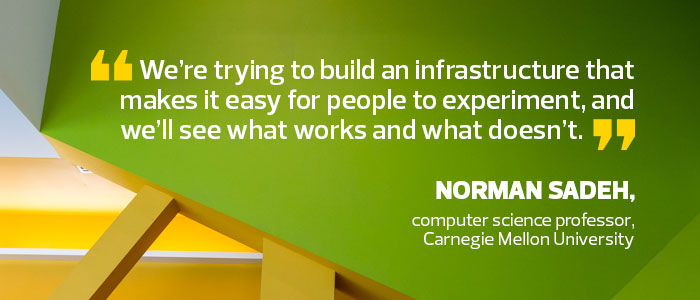Internet of Things: Coming to Your Campus Soon
To some tech observers, it feels like the Internet of Things has been the “next big thing” forever, without actually turning into the current big thing. But, says Carnegie Mellon University computer science professor Norman Sadeh, a number of IoT use cases are already present on college campuses, and more will follow as developers have the tools necessary to create them.
“When people built smartphones and launched app stores, they didn’t really know what the ‘killer app’ would be,” says Sadeh, who leads the privacy component of CMU’s Google-funded, multiuniversity effort to create a new IoT platform. “We’re in a similar situation with the Internet of Things. We’re trying to build an infrastructure that makes it easy for people to experiment, and we’ll see what works and what doesn’t. We don’t really know.”
Carnegie Mellon is teaming up with researchers at Cornell University, Stanford University, the University of Illinois and Google to create an IoT platform called GIoTTO, after the 14th century Italian painter. It will include inexpensive and easy-to-deploy sensors, new middleware to facilitate app development and manage privacy and security, and new tools to help users create their own IoT experiences.
But even now, colleges are embracing existing IoT technologies for use cases as varied as facilities and operations, health and fitness, and distance learning. Gartner predicts the number of connected devices will more than triple, to 21 billion by 2020 — the same year that this fall’s incoming college freshmen will receive their diplomas.

SOURCE: IDC, “Worldwide Internet of Things Forecast, 2015–2020,” May 2015
Current and Future Uses
Jan-Martin Lowendahl, a Gartner research vice president and analyst who specializes in education, points to two factors driving early IoT use cases in higher education: students bringing consumer IoT devices onto campus and institutions adopting smart systems to conserve energy. In some cases, these two IoT drivers have merged, Lowendahl says, with students asking to connect their smart light bulbs to an institution’s networks. “I think that’s where IoT excels,” Lowendahl says, “with sensors that regulate systems and help save money.”
The IoT’s potential use cases, however, are far more expansive. Lowendahl cites facial recognition to determine whether students in online classes are fully engaged with their learning, or location tracking that scans for early signs of depression, such as students skipping meals or staying in their residence halls for days on end. The challenge for these use cases isn’t just technological (after all, the tools to track student location already exist), but is also rooted in processes and privacy policies, Lowendahl says.
“The key problem is that schools do not yet know how to deal with all this data,” he says. “When there is a trigger, like a student hasn’t been to the cafeteria for a week, how do you engage with students in a way that they don’t feel creeped out?”
In 2015, all incoming freshmen at Oral Roberts University began using activity trackers that sync up with the institution’s electronic grade book. For decades, the university, which takes a “whole person” approach to education, has required students to track the number of steps they take each day. Until recently, students kept manual logs for faculty members to check.
“With the Fitbit, people put it on their wrist, and it pulls in all that data without faculty having to even look at it until the end of the semester, saving hundreds of hours,” says CIO Mike Mathews, who also provides global education strategies for the university.
Oral Roberts has also used telepresence robots to let students participate in distance learning. “Last semester, we broadcast 520 instructional hours through robots to people in unexpected medical situations,” says Mathews. “To me, that’s that many more people who could continue on their educational pathway instead of stopping.”
As the IoT goes mainstream, it will place new strains on IT resources, the same way that personal computers and mobile devices once did. The proliferation of new connected devices will, of course, increase capacity demands, but IT shops will also face questions around security, privacy and interoperability.
“When there’s this much publicly available data about people, what happens when you combine all that data, and what could it tell somebody about your life patterns?” says Margaret Loper, chief technologist in the Center for the Development and Application of Internet of Things Technologies at Georgia Tech. “When these sensor environments are all around us, what does that mean from a privacy perspective?”

New Demands on IT
Carnegie Mellon’s Sadeh believes that artificial intelligence may be the key to assuaging privacy concerns. As he points out, people don’t have time to read the privacy policies of all IoT technologies they use. Machine learning could solve that dilemma. An AI assistant on mobile devices could learn which privacy issues an individual cares about, watch for data-gathering practices that may be troubling, and selectively alert the user about them.
“Privacy is essential to the adoption of IoT,” Sadeh says. “If you look at studies, one of the major obstacles to adoption is privacy, and the other is security.” As for the latter, he says, the IoT is a “potential nightmare.”
“We already live in a world where everything is being hacked all the time,” he says. “You deploy more technology, and that introduces more vulnerabilities, which means the bad guys will have more opportunities to do bad things.”
Sadeh notes that researchers have already uncovered vulnerabilities in connected devices such as cars and pacemakers. He warns that hackers could launch phishing-style attacks on IoT devices, sending legitimate-looking requests to pair with a device, only to infect it and steal the user’s data.
“People are experimenting all of the time,” Sadeh says. “You have to find the right balance between allowing people to experiment and making sure people think through all the possible risks.”









